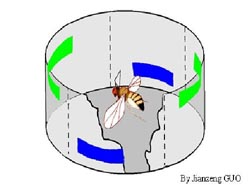
As a result of their three-year studies in
Drosophilae (fruit flies), CAS scientists reveal that memory and learning in the insect could be enhanced by stimuli combining olfactory (or smell) and visual signals.
In its evolutionary history, an organism could develop various sensory modalities (or channels) in the form of sight, hearing, smell, taste, touch and pain. These modalities serve as interfaces or pathways for the brain to exchange data with the outside world. In the merciless competition characterized by survival of the fittest, the multi-channel perception could be critical for the survival of a species, because different modalities of sensation may interact in a synergistic manner and help the organism make a reliable choice and rapid response. However, in what way does the brain integrate information from multi-channel perception during memory acquisition? Whether there is also interaction during the process? These questions are largely unsolved to scientists.
As reported in the July 8 issue of
Science, a research group headed by Prof. Guo Aike, a CAS member concurrently working at the CAS Institute of Neuroscience and the CAS Institute of Biophysics, created an ingenious device -- a modified version of the classical visual flight simulator-- to study the issue.
They first defined the threshold level at which the separate stimulus for a visual or olfactory learning of the
Drosophila is reduced to a minimum that is statistically indifferent from zero. And then they conditioned flies with paired visual and olfactory clues at the threshold level. The researchers find that the insect's response to its learning or memory process is significant.
This shows in
Drosophila reinforcement learning that conditioning with concurrent visual and olfactory cues could reduce the threshold for unimodal memory retrieval. Further studies of the group confirm bimodal preconditioning followed by unimodal conditioning with either a visual or olfactory cue led to crossmodal memory transfer.
The discovery in
Drosophilae may have implications for human learning, according to Prof. Guo. Although it is about only 2 mm in body length, many genes of Drosophila are homologous to human ones, and its behavior is pretty complicated. Thanks to its simplified chromosome system (four pairs) and short generation time (about 20 days), the insect is an ideal model organism for scientific research of human intelligence.
The research might prove useful in developing memory-enhancing techniques for humans, according to Prof. Guo. "It's similar to the phenomenon of crossmodal facilitation in human beings that the nose smells what the eye sees" says Prof. Guo.
Through an analytic research of the interactions between the genetic code, brain and behavior, neuroscientists might make critical steps in revealing the mysteries of intelligence and creativity origin, adds Prof. Guo.







